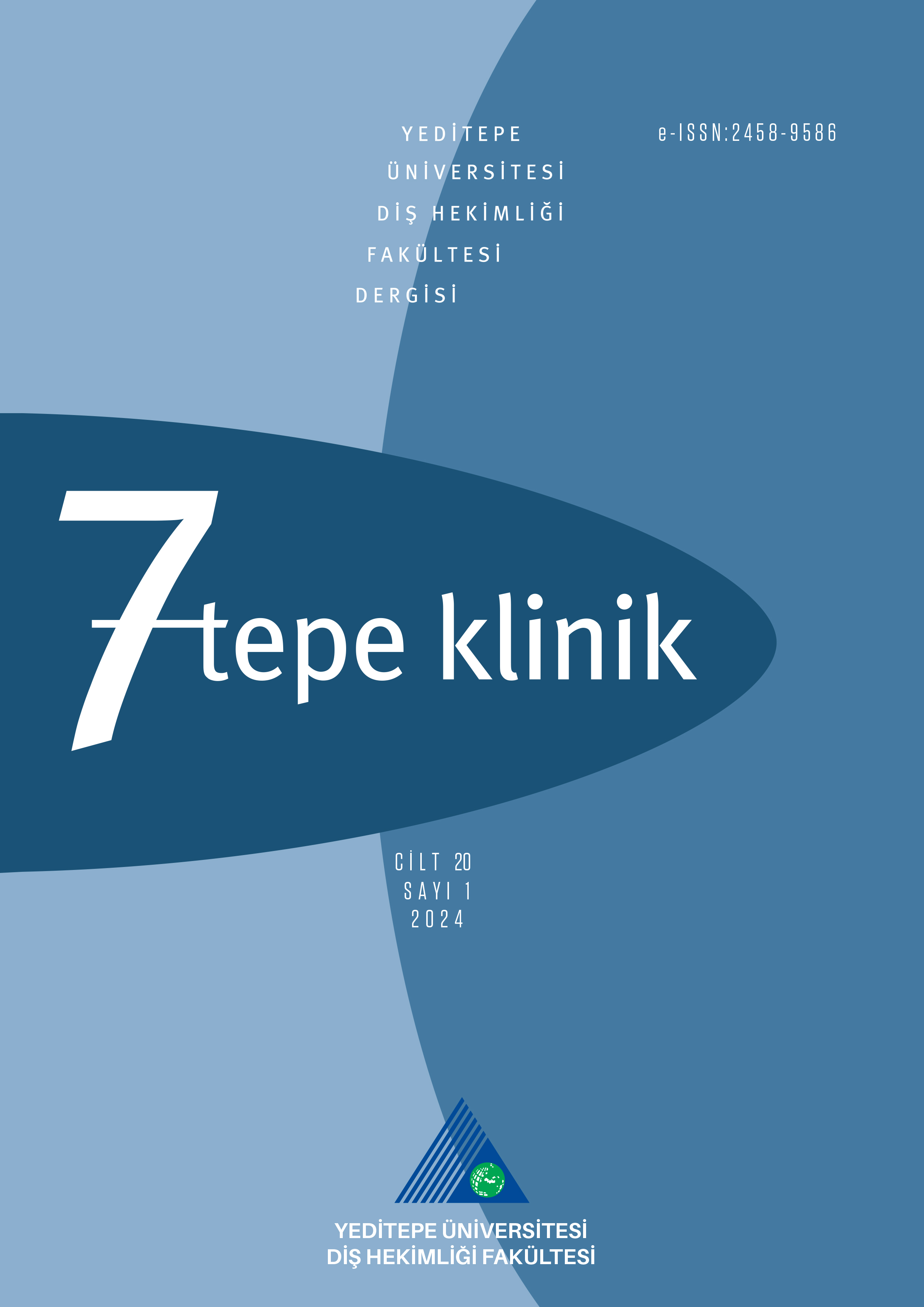İki farklı döner eğe sistemi ile şekillendirilmiş dişlerin farklı irrigasyon solüsyonları kullanıldığında kırılma dirençlerinin değerlendirilmesi
Esra Yaman, Berna Aslan, Funda YılmazAnkara Üniversitesi Diş Hekimliği Fakültesi, Endodonti A.D., AnkaraGİRİŞ ve AMAÇ: Bu deneysel çalışmanın amacı iki farklı döner eğe sistemi ile prepare edilmiş, dişlerin farklı irrigasyon solüsyonları kullanıldığında kırılma dirençlerinin karşılaştırılmasıdır.
YÖNTEM ve GEREÇLER: Çalışmada 98 adet tek köklü alt çene küçük azı dişler premolar kullanıldı. Dişlerin kök uzunlukları 13 mm olacak şekilde kuronları uzaklaştırıldı. Kökler 3 kontrol grubuna ve 4 deneysel gruba ayrıldı (n=14). Negatif kontrol grubuna (n=14) hiç işlem yapılmadan bırakıldı. Pozitif Kontrol Grupları; Grup PUP (ProTaper, serum fizyolojik) ve Grup WOP (WaveOne, serum fizyolojik), Deneysel Gruplar; Grup PUSP (ProTaper, NaOCl), Grup WOSP (WaveOne, NaOCl), Grup PUSEP (ProTaper, EDTA) ve Grup WOSEP (WaveOne, EDTA) oluşturuldu. Son irrigasyon olarak serum fizyolojik tüm deney gruplarına ve pozitif kontrol gruplarına uygulandı. Periodontal aralık taklit edilecek şekilde örnekler akrilik rezine gömüldü. Daha sonra Kontrol ve deney gruplarına ait tüm örnekler, Universal Test Cihazı kullanılarak, kırılma testine tabi tutulup kırılma anındaki değer her kök için Newton birimi üzerinden kaydedildi. Ölçüm sonuçları arasındaki farklılıklar test edilirken Kruskall-Wallis H testi, hangi grupların birbirinden farklı olduğunu tespit etmek amacıyla Post-Hoc Çoklu Karşılaştırma Testi kullanıldı. p değerinin, 0,05ten küçük olduğu değerler istatistiksel olarak anlamlı kabul edildi.
BULGULAR: Negatif Kontrol Grubu KP (371,71 N), Grup PUP (199,92 N), Grup PUSP (210,28 N) ve Grup PUSEP (220,89 N)e göre istatistiksel olarak anlamlı ölçüde daha fazla kırılma direnci gösterirdi. ProTaper grupları ve WaveOne grupları arasında da istatistiksel olarak anlamlı bir farklılık olduğu tespit edildi (p<0,05). Aynı Ni-Tİ sistemler kendi içinde değerlendirildiğinde farklı irrigasyon rejimi uygulamanın dişin kırılma direnci üzerine etkisi istatistiksel olarak anlamlı bulunmadı (p>0.05).
TARTIŞMA ve SONUÇ: Bu çalışmanın sınırları dahilinde, elde ettiğimiz sonuçlara göre ProTaper döner eğe sistemi kullanılması dişin kırılma direncini istatistiksel olarak düşürdüğü, ancak farklı irrigasyon solüsyonları kullanılmasının dişin kırılma direncin üzerine etkisi olmadığı bulunmuştur.
Evaluation of the effects of two different rotary systems and various irrigants on the fracture resistance of teeth
Esra Yaman, Berna Aslan, Funda YılmazDepartment of Endodontics,Faculty of dentistry, Ankara University, Ankara, TurkeyINTRODUCTION: This is an experimental study conducted on extracted teeth and aiming to evaluate the effect of various root canal irrigation solutions on fracture resistance of the roots.
METHODS: Ninety-eight single rooted mandibular premolar teeth were used. Crowns were removed from the enamel-cementum junction and root lenghts were adjusted to 13 mm. The roots were divided into 3 control groups and 4 experimental groups (n=14). As negative control group 14 teeth without any treatment were used. The other groups were divided as the Positive Control Groups; Group PUP (ProTaper, Serum physiologic), Group WOP (WaveOne, Serum physiologic), and Experimental Groups; Group PUSP (ProTaper, NaOCl), Group WOSP (WaveOne, NaOCl), Group PUSEP (ProTaper, EDTA) and Group WOSEP (WaveOne, EDTA). Serum physiologic was used for final irrigation in experimental groups as well as positive control groups. Specimens were embedded into acrylic resin and periodontal ligament was created for all groups. Then specimens were submitted to a fracture test using a Universal Test Machine and the load necessary to fracture was recorded and expressed in Newton (N). The differences between the groups were tested by Kruskall-Wallis H test and Pos- Hoc multiple comparison test. P values below 0,05 were accepted as statistically significant.
RESULTS: The Negative Control Group showed the higher fracture resistance (371.71 N) from Positive Control Group PUP (199.92 N), Group PUSP (210.28 N) and Group PUSEP (220.89 N) (p˂0,05). There were statistically significant differences between ProTaper groups and WaveOne groups (p˂0.05). There were no statistically signifacant differences within experimental groups shaped with same Ni-Ti system and irrigated with various regimes (p˃0.05).
DISCUSSION AND CONCLUSION: Within the limitations of this study, according to our results, usage of ProTaper rotary system decreased the fracture resistance of teeth significantly. However the usage of different irrigation solutions did not effect the fracture resistance of teeth.
Sorumlu Yazar: Funda Yılmaz, Türkiye
Makale Dili: Türkçe



